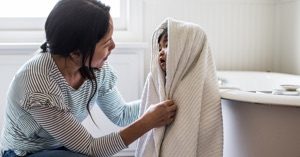Summer first aid essentials for parents
As outdoor temperatures rise, many of us are excited to enjoy more time outdoors in the sun. Whether you’re itching to strap on your hiking boots and hit a new trail or set out with the kids on a bike ride, the summer months bring a unique set of health and safety concerns.
Enter, the first aid kit—an essential resource for every parent and household. Common summer ailments like cuts and scrapes, insect bites and poison ivy are no match when you have a well-stocked kit at your disposal. Let’s walk through the supplies you need, where to store your kit and what to do if you need additional medical care and treatment.
What do I need in my first aid kit?
Be prepared when the unexpected accident or injury occurs. Having the right first aid supplies means you can quickly tend to minor injuries while at home or on the go.
First aid kit staples
- Antiseptic wipes or spray – Skinned knees and cut fingers are a rite of passage of childhood. When these minor injuries occur, you need a way to quickly clean wounds of dirt and debris. When at home, mild soap and water works best.
- Band aids – These wonderful little sticky inventions come in a variety of sizes and help keep cuts and scrapes covered and clean. For parents, it’s wise to consider investing in some fun varieties because, yes … in your child’s mind, that dinosaur band aid does work much better than the plain old variety.
- Sterile gauze pads and adhesive tape – When a basic band aid won’t do the job, fasten a no-stick sterile gauze pad with tape to protect the injury site. These pads are especially useful for larger wounds when antibiotic ointment is needed.
- Tweezers – Slivers are no match for these little metal wonders, which can also be used to carefully remove ticks. Depending on the job at hand (or foot), it may be a good idea to stock a couple different types.
- Sharp scissors – From cutting a gauze pad to the perfect size to cutting through fabric to quickly tend to a wound, a sharp pair of scissors gets the job done quickly and efficiently and really beats trying to use your teeth.
- Thermometer – Your child’s skin is flushed and feels hot to the touch. Now what? The only sure way to know whether your child’s fever is normal or may be more serious is to use a thermometer to take and monitor their temperature.
- Acetaminophen and ibuprofen (for kids and adults) – From aches and pains to fevers and headaches, these over-the-counter medications can quickly quiet symptoms and help you and your little one feel better fast.
- Antibiotic cream – To ward off infection and aid in healing, use antibiotic creams or ointments on clean skin and cover with a band aid or bandage. To avoid possible skin reactions, skip the triple antibiotics and opt for the simple version with bacitracin.
- Instant cold pack — Who needs ice! When bumps and bruises occur, an instant cold pack can be a godsend. Apply a cold pack to the injured area to numb pain and reduce swelling.
- Topical or oral itch relief — Bug bites, rashes and itchy watery eyes can make you miserable. To soothe irritated skin, use a cream with 1% hydrocortisone. To calm allergy symptoms, take an oral antihistamine like Benadryl or Allegra.
Where should I keep a first aid kit?
Ok, your first aid kit is ready to take on the inevitable and impending bumps, blisters and bruises. Now, where should you keep it? For most people, it makes sense to store your kit in a bathroom cabinet or hallway linen closet. But what happens when your child falls off their bike on a trail ride or is nearly eaten alive by mosquitos while camping? This is where travel first aid kits come in really handy. For daytrip adventures, pack a smaller version of your home kit in your purse or backpack. It’s also a good idea to keep a kit in your car—complete with emergency flares, jumper cables and a blanket.
When to seek help from a medical professional
For many families, scrapes, bug bites and sunburns are just part of the summer experience. But sometimes, it’s hard to know whether that cut can be treated with just a kiss from mom or dad and a band aid, or if it needs to be assessed by a doctor.
When you need advice from a medical professional, we’re here to help you determine the best course of action. Visit our online clinic to get treatment fast—so you can get back to enjoying summer.
Share this post
Do you know someone who could use a simple & affordable healthcare option?

